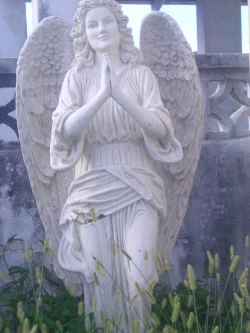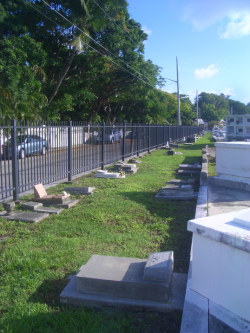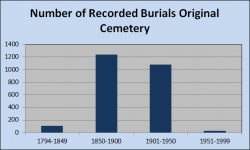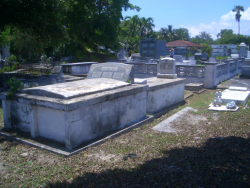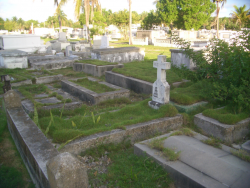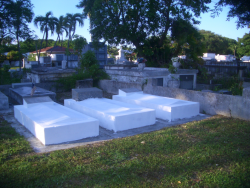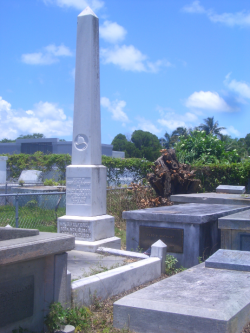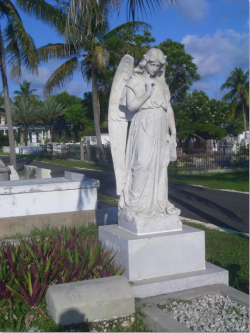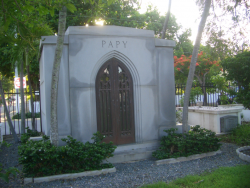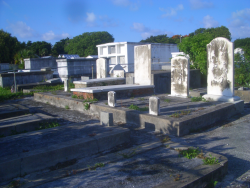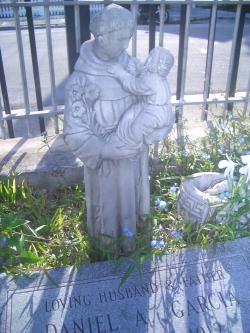Between 60,000 and 100,000 souls rest in the Key West Cemetery - in acreage designed to bury less than 20,000. They lay above ground and below. Side-by-side and stack-a-top. Under the shade of poincianas and almond trees or under relentless sunshine. Family members lay one atop another in the same earthen grave, separated by a little coarse soil but now laying together through dust and time - exhume the old and rebury with the new. Some rest with the gifts of voodoo, others placed asunder to the jazz-band horns that arrive in melancholy and depart in revelry. Entire families live next to each other, scores of infants rest alone and the noteworthy recline in grandeur. A few headstones offer tourists a chuckle, most give glory and thanks for a peaceful eternity and victory over death. There are heroes and heroines from wars and disease. Fully integrated in race, creed and color since its inception, the cemetery is as accepting in eternal death as the City is in its daily life. The cemetery is in the middle of Old Town and it is the soul of Key West’s heart.
In the beginning ...
A horrendous hurricane in October 1846 descimated the existing cemetery in low-lying SE Key West, washing bodies and caskets across the island. In 1847 the City of Key West bought 4 acres on the (then) outskirts of town for $400 from L. Windsor Smith. Not only were remains re-interred, but other burial areas, mostly church grounds, moved their cemeteries to this new site. Next came a 300 sq.ft. plot bought in 1861 by the Key West Catholic Church. This area is at the NW corner of the cemetery where Angela St and Frances St. intersect. In 1925 the Florida Dept. of Public Health expanded the cemetery to its present size.
Today, the cemetery, now on "high" ground and in the middle of and surrounded by Old Town, encompasses 19 acres with the original 4-acre plot along Angela St. to the north and William St./Windsor Lane to the west. Because of interior roadways and pathways, there are 15 usable acres. There are two gates into the cemetery. All may enter through the main gate at the SW corner via Margaret St., and a non-car gate is on the east side along Frances St. Except for funerals, the cemetery is open to the public year-round, essentially sunrise to sunset. City ordinances prevent motorcycles, mopeds and dogs in the cemetery as well as no playing on, around or disfiguring gravesites.
Here's a map that is also available at the sexton's office (305.292.6718) just inside the main gate. Of note, in the original cemetery, the area along Passover Lane was reserved for burying infants and children. Throughout the cemetery there are many tombs, mostly cradle in design, of children and infants, testament to the rigors of early life and the dangers of child birth in those "good ole days".
As a port town, Key West in the 1800's was second to none. As such it was susceptible to the killer diseases transported by the commercial and navy ships of the 1800's. Notable among these were yellow fever, typhoid and malaria. These diseases spread easily among the hot, humid and often unsanitary port cities of the southeast US and Caribbean. The worst was yellow fever with a mortality rate exceeding 30%. Children and elderly were easy prey. In 1853-54, 62-63, 67, 73-74, 82-83, yellow fever struck Key West and cemetery records record the damage. Not until medical advances in the late 1890s and early 1900s by Dr. William Gorgas and Walter Reed were these killer diseases put mostly to rest.
There are six primary types of gravesites in the Key West cemetery. Each owes its design and usage to the soil of Key West; that is, hard coral rock under a minimum of earth. These six types of tombs are:
Box. Box tombs are the most common. Measuring 3' x 6' x 3' they rest above the earth, are made of concrete and are strong enough to be stacked. Usually there is a cement lid overlapping the edges of the box. Often times boxes are placed side by side and one atop another.
Cradle. Cradle tombs are a raised masonry enclosure that form a perimeter around the grave and may or may not be filled with earth, stones, masonry. They are often unmarked as they likely had a head marker of wood which is now deteriorated. Cradle graves are predominantly pre-civil war.
Low. Low tombs are one-half as high as Boxes. They have a slight gable peak and often have incised markers. Low tombs date to the1st half of the 20th Century.
Markers. Marker tombs by their design reflect a degree of wealth. They are constructed of marble, concrete or granite and sit on top of the burial site. Marble is susceptible to deterioration from heavy rainfall, pollution and organic growth/root intrusion. Granite is the most durable.
Statuary. Statuary tombs are the most expressive of the tomb types and yet are the most vulnerable - to vandalism and deterioration. Restorers must use caution and avoid use of dissimilar elements in the restoration.
Vaults. Few in number, vault tombs offer not just a secure site for multiple burials but a place for the visitor to sit and contemplate. Oftentimes vaults also contain momentos or photos of the deceased.
A 1976 report on the cemetery by the state declared the cemetery a health hazard. Tomb deterioration, vandalism, litter and untended tropical growth compelled Key West to re-evaluate its commitment to the cemetery. Additional staff, social resolve and dedicated funding has done much to restore the cemetery. But dollars are tight and commercialization of the cemetery (tours) has been restricted.
Two reports; one in 1996 by the Center for Historic Cemeteries Preservation, Tallahasse, FL and the other in 2002 for the City of Key West by the Historic Preservation Services, Navarre, FL provided research, burial documentation and a Master Preservation Plan for maintaining the cemetery as a historical site and treasure. (Neither report is available on the internet).
Several people were instrumental in bringing these reports to life and continuing to keep the cemetery as a line item in the Key West budget. Among these stalwarts are Diane Silvia, a Historic Preservation Planner and Sharon Wells, member of the Cemetery Historical team.
The primary concerns are to preserve the historical value of the cemetery, establish guidelines for future burials and keep the cemetery open as a living aspect of Key West for residents and visitors.
The restoration of the cemetery is a continuous long-term process that survives through a mix of state grant money, local contractors and eager volunteers. If you would like to volunteer your time and energy for a truly noble and historic cause, please contact Diane Silvia at 305.292.6718.
I encourage you to wander through the cemetery. There are some beautiful sites, thoughts and opportunities to measure your mortality.
In conclusion -“I always remember an epitaph which is in the cemetery at Tombstone, Arizona. It says: ''Here lies Jack Williams. He done his damnedest.'' I think that is the greatest epitaph a man can have.” - Harry S Truman.
If you have questions or comments, please contact me here.
Good luck.
Additional resources:





